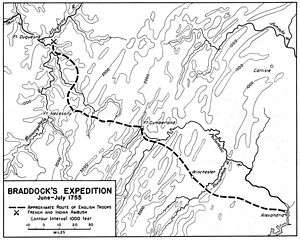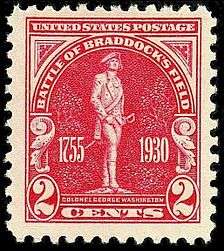Battle of the Monongahela
| ||||||||||||||||||||||||||||||
The Battle of the Monongahela, (also known as the Battle of Braddock's Field and the Battle of the Wilderness), took place on 9 July 1755, at the beginning of the French and Indian War, at Braddock's Field in what is now Braddock, Pennsylvania, 10 miles (16 km) east of Pittsburgh. A British force under General Edward Braddock, moving to take Fort Duquesne, was defeated by a force of French and Canadian troops under Captain Daniel Liénard de Beaujeu with its American Indian allies.
The defeat marked the end of the Braddock expedition, by which the British had hoped to capture Fort Duquesne and gain control of the strategic Ohio Country. Braddock was mortally wounded in the battle and died during the retreat near present-day Uniontown, Pennsylvania. He specifically asked for George Washington, who accompanied him on the march, to oversee his burial. The remainder of the column retreated south-eastwards and the fort, and region, remained in French hands until its capture in 1758.
Background
Braddock had been dispatched to North America in the new position of Commander-in-Chief, bringing with him two regiments (the 45th and 48th) of troops from Ireland.[5] He added to this by recruiting local troops in British America, swelling his forces to roughly 2,200 by the time he set out from Fort Cumberland, Maryland on 29 May.[6] He was accompanied by Virginia Colonel George Washington, who had led the previous year's expedition to the area.[1]
Braddock's expedition was part of a four-pronged attack on the French in North America. Braddock's orders were to launch an attack into the Ohio Country, disputed by Britain and France. Control of the area was dominated by Fort Duquesne on the forks of the Ohio River. Once it was in his possession, he was to proceed on to Fort Niagara, establishing British control over the Ohio territory.
He soon encountered a number of difficulties. He was scornful of the need to recruit local Native Americans as scouts, and left with only eight Mingo guides. He found that the road he was trying to use was slow, and needed constant widening to move artillery and supply wagons along it. Frustrated, he split his force in two, leading a flying column ahead, with a slower force following with the cannon and wagons.[6]
The flying column of 1,300 crossed the Monongahela River on 9 July, within 10 miles (16 km) of their target, Fort Duquesne. Despite being very tired after weeks of crossing extremely hard terrain, many of the British and Americans anticipated a relatively easy victory—or even for the French to abandon the fort upon their approach.[7]
Fort Duquesne had been very lightly defended, but had recently received significant reinforcements.[8] Claude-Pierre Pecaudy de Contrecœur, the Canadian commander of the fort, had around 1,600 French troupes de la Marine, Canadian militiamen and Native American allies. Concerned by the approach of the British, he dispatched Captain Daniel Liénard de Beaujeu with around 800 troops, (108 Troupes de la Marine, 146 Canadian militia, and 600 Indians),[9] to check their advance.[10]
Battle
The French and Indians arrived too late to set an ambush, as they had been delayed, and the British had made surprisingly speedy progress. They ran into the British advance guard, commanded by Lieutenant Colonel Thomas Gage. Seeing the enemy in the trees, Gage ordered his men to open fire. Despite firing at very long range for a smooth-bored musket, their opening volleys succeeded in killing Captain Beaujeu.
Unconcerned by the death of Beaujeu, the Indian warriors took up positions to attack. They were fighting on an Indian hunting ground which favored their tactics, with numerous trees and shrubbery separated by wide open spaces. Although roughly a hundred of the Canadians fled back to the fort, Captain Dumas rallied the rest of the French troops. The Indian tribes allied with the French, the Ottawas and Potawatomis, used psychological warfare against the British forces. After the Indians killed British soldiers, they would nail their scalps to surrounding trees. During the battle, Indians made a terrifying "whoop" sound that caused fear and panic to spread in the British infantry.[11]
As they came under heavy fire, Gage's advance guard began taking casualties and withdrew. In the narrow confines of the road, they collided with the main body of Braddock's force, which had advanced rapidly when the shots were heard. Despite comfortably outnumbering their attackers, the British were immediately on the defensive. Most of the regulars were unused to fighting in woods, and were terrified by the deadly musket fire. Confusion reigned, and several British platoons fired at each other.[12] The entire column dissolved in disorder as the Canadian militiamen and Indians enveloped them and continued to snipe at the British flanks from the woods on the sides of the road. At this time, the French regulars began advancing along the road and began to push the British back. General Braddock rode forward to try to rally his men, who had lost all sense of unit cohesion.

Following Braddock's lead, the officers tried to reform units into regular order within the confines of the road. This effort was mostly in vain, and simply provided targets for their concealed enemy. Cannon were used, but due to the confines of the forest road, they were ineffective. Braddock had several horses shot under him, yet retained his composure, providing the only sign of order to the frightened British soldiers.[12] Many of the Americans, lacking the training of British regulars to stand their ground, fled and sheltered behind trees, where they were mistaken for enemy fighters by the redcoats, who fired upon them.[12] The rearguard, made up of Virginians, managed to fight effectively from the trees—something they had learned in previous years of fighting Indians.[13]
Despite the unfavorable conditions, the British began to stand firm and blast volleys at the enemy. Braddock believed that the enemy would eventually give way in the face of the discipline displayed by the English-led troops. Despite lacking officers to command them, the often makeshift platoons continued to hold their crude ranks.
Finally, after three hours of intense combat, Braddock was shot in the lung, possibly by one of his own men,[14][15] and effective resistance collapsed. He fell from his horse, badly wounded, and was carried back to safety by his men. As a result of Braddock's wounding, and without an order being given, the British began to withdraw. They did so largely with order, until they reached the Monongahela River, when they were set upon by the Indian warriors. The Indians attacked with hatchets and scalping knives, after which panic spread among the British troops and they began to break ranks and run, believing they were about to be massacred.
Colonel Washington, although he had no official position in the chain of command, was able to impose and maintain some order, and formed a rear guard, which allowed the remnants of the force to disengage. By sunset, the surviving British forces were fleeing back down the road they had built, carrying their wounded. Behind them on the road, bodies were piled high. The Indians did not pursue the fleeing redcoats, but instead set about scalping and looting the corpses of the wounded and dead, and drinking two hundred gallons of captured rum.[16]
Aftermath
Of the approximately 1,300 men Braddock led into battle,[1] 456 were killed outright and 422 were wounded. Commissioned officers were prime targets and suffered greatly: out of 86 officers, 26 were killed and 37 wounded. Of the 50 or so women that accompanied the British column as maids and cooks, only 4 returned with the British; about half were taken as captives. The French and Canadians reported very few casualties.
Braddock died of his wounds on July 13, four days after the battle, and was buried on the road near Fort Necessity.

Colonel Thomas Dunbar, with the reserves and rear supply units, took command when the survivors reached his position. Realizing there was no further likelihood of his force proceeding to capture Fort Duquesne, he decided to retreat. He ordered the destruction of supplies and cannon before withdrawing, burning about 150 wagons on the spot. His forces retreated back toward Philadelphia. The French did not pursue, realizing that they did not have sufficient resources for an organized pursuit.
Legacy
The battle was a devastating defeat, and has been characterized as one of the most disastrous in British colonial history.[17] It marked the end of the Braddock expedition, which many had believed contained overwhelming force, to seize the Ohio Country. It awakened many in London to the sheer scale of forces that would be needed to defeat the French and their Indian allies in North America.[18]
The inability of the redcoats to use skirmishers, and the vulnerability this caused for the main force, had a profound effect on British military thinking. Although Braddock had posted a company of flankers on each side, these troops were untrained to do anything but stand in line and fire platoon volleys, which were unsuited to such conditions. Learning from their mistakes the British made much better use of skirmishers, often equipped with rifles, who could protect the main body of troops from such devastating fire, both later in the French and Indian War and in the American War of Independence.
Because of the speed with which the French and Indians launched their attack and enveloped the British column, the battle is often erroneously reported as an ambush by many who took part. In fact, the French had been unprepared for their contact with the British, whom they had blundered into. The speed of their response allowed them to quickly gain the upper hand, and brought about their victory.
The French remained dominant in the Ohio Country for the next three years, and persuaded many previously neutral Indian tribes to enter the war on their side.[17] The French were eventually forced to abandon Fort Duquesne in 1758 by the approach of the Forbes Expedition.
Commemorations

In 1930, on the 175th anniversary of the Battle of Braddocks Field, a statue of Colonel Washington was unveiled, and a commemorative postage stamp, modeled after that statue, was released for usage the same day.
See also
References
- 1 2 3 "The Battle of the Monongahela". World Digital Library. 1755. Retrieved 2013-08-03.
- 1 2 3 Borneman p.55
- ↑ Borneman p.55—French: 28 killed 28 wounded, Indian:11 killed 29 wounded
- ↑ Frank A. Cassell. "The Braddock Expedition of 1755: Catastrophe in the Wilderness". Archived from the original on 7 June 2010. Retrieved 1 July 2010.
- ↑ Anderson p.67-71
- 1 2 Anderson p.96
- ↑ Anderson p.97
- ↑ Dull p.31
- ↑ W. J. Eccles, France in America, p184
- ↑ Anderson p.98-99
- ↑ Ward, Matthew C. (1995), "Fighting the "old Women"", The Virginia Magazine of History and Biography: 297+.
- 1 2 3 Anderson p.102
- ↑ Anderson p.102-3
- ↑ Hadden, 117
- ↑ According to Crocker, Tom Fausett (1713?-1822) shot Braddock to avenge his brother whom Braddock caught cowering on the battlefield and ran through with his sword. He was something of a character and there are doubts about this story. He later settled in western Pennsylvania and died, it is said, at the age of 109.
- ↑ Anderson p.103-4
- 1 2 McLynn p.35
- ↑ McLynn p.35-36
Bibliography
- Anderson, Fred (2000). Crucible of War: The Seven Years' War and The Fate of Empire in British North America, 1754–1766. New York: Alfred A. Knopf. ISBN 0-375-40642-5.
- Crocker, Thomas E. (2011). Braddock's March. London.
- Borneman, Walter R. (2007). The French and Indian War. Rutgers. ISBN 978-0-06-076185-1.
- Dull, Jonathan R. (2005). The French Navy and the Seven Years' War. New York: University of Nebraska Press. ISBN 0-8032-1731-5.
- Hadden, James (1910) [1755]. Washington's Expedition (1753-1754) and Braddock's Expedition. Uniontown, PA: James Hadden.
- Ellis, Joseph J. (2008) [2004]. George Washington: His Excellency. United States.
- McLynn, Frank (2004). 1759: The Year Britain Became Master of the World. New York: Atlantic Monthly Press. p. 322. ISBN 0-87113-881-6.
